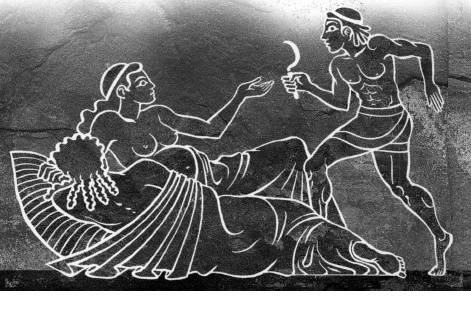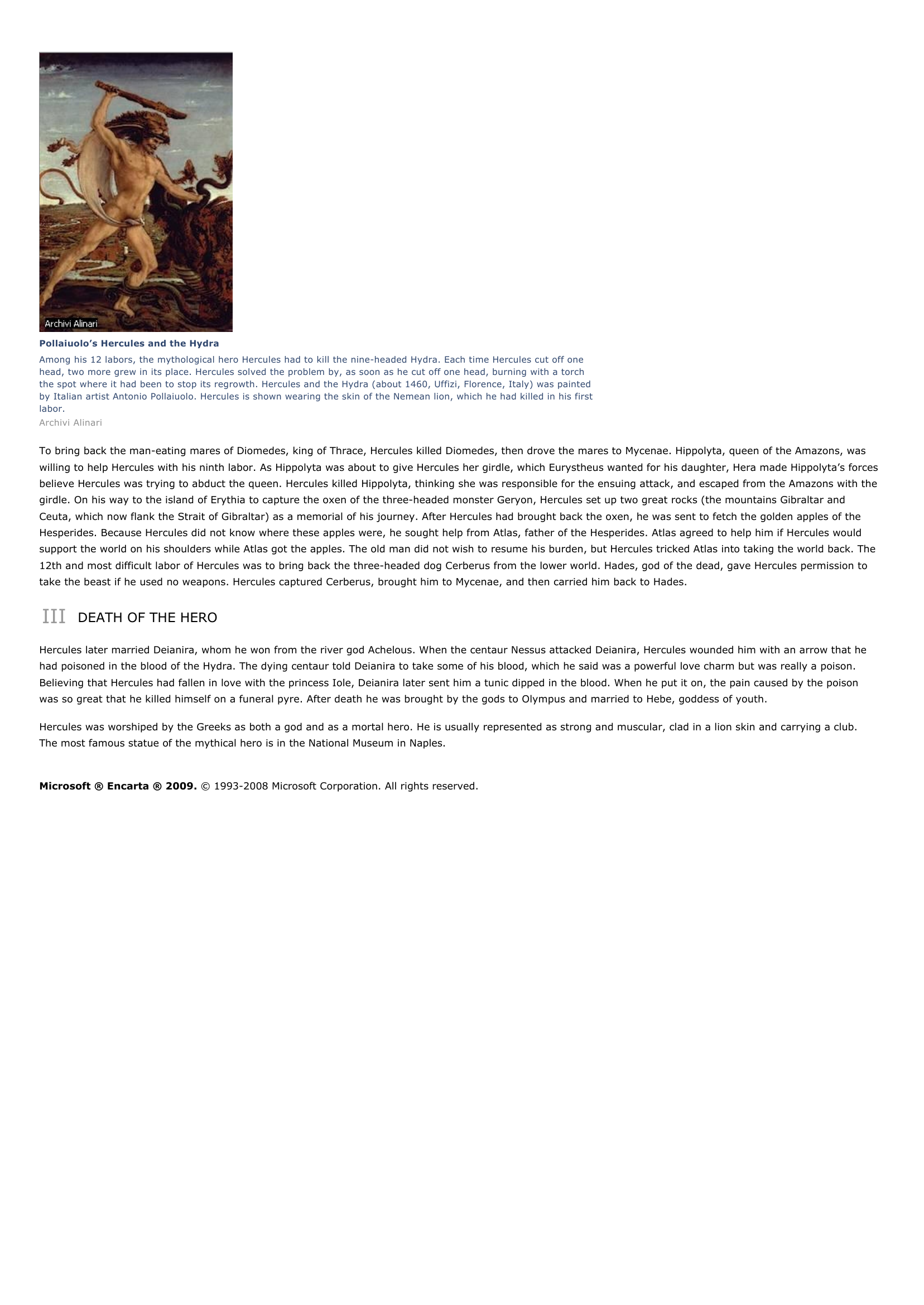Hercules (mythology) I INTRODUCTION Pollaiuolo's Hercules et Antaeus In a wrestling match, Hercules triumphed over the mighty giant Antaeus, who received his strength from his mother, the Earth goddess Gaia.
Publié le 12/05/2013

Extrait du document


«
Pollaiuolo’s Hercules and the HydraAmong his 12 labors, the mythological hero Hercules had to kill the nine-headed Hydra.
Each time Hercules cut off onehead, two more grew in its place.
Hercules solved the problem by, as soon as he cut off one head, burning with a torchthe spot where it had been to stop its regrowth.
Hercules and the Hydra (about 1460, Uffizi, Florence, Italy) was paintedby Italian artist Antonio Pollaiuolo.
Hercules is shown wearing the skin of the Nemean lion, which he had killed in his firstlabor.Archivi Alinari
To bring back the man-eating mares of Diomedes, king of Thrace, Hercules killed Diomedes, then drove the mares to Mycenae.
Hippolyta, queen of the Amazons, waswilling to help Hercules with his ninth labor.
As Hippolyta was about to give Hercules her girdle, which Eurystheus wanted for his daughter, Hera made Hippolyta’s forcesbelieve Hercules was trying to abduct the queen.
Hercules killed Hippolyta, thinking she was responsible for the ensuing attack, and escaped from the Amazons with thegirdle.
On his way to the island of Erythia to capture the oxen of the three-headed monster Geryon, Hercules set up two great rocks (the mountains Gibraltar andCeuta, which now flank the Strait of Gibraltar) as a memorial of his journey.
After Hercules had brought back the oxen, he was sent to fetch the golden apples of theHesperides.
Because Hercules did not know where these apples were, he sought help from Atlas, father of the Hesperides.
Atlas agreed to help him if Hercules wouldsupport the world on his shoulders while Atlas got the apples.
The old man did not wish to resume his burden, but Hercules tricked Atlas into taking the world back.
The12th and most difficult labor of Hercules was to bring back the three-headed dog Cerberus from the lower world.
Hades, god of the dead, gave Hercules permission totake the beast if he used no weapons.
Hercules captured Cerberus, brought him to Mycenae, and then carried him back to Hades.
III DEATH OF THE HERO
Hercules later married Deianira, whom he won from the river god Achelous.
When the centaur Nessus attacked Deianira, Hercules wounded him with an arrow that hehad poisoned in the blood of the Hydra.
The dying centaur told Deianira to take some of his blood, which he said was a powerful love charm but was really a poison.Believing that Hercules had fallen in love with the princess Iole, Deianira later sent him a tunic dipped in the blood.
When he put it on, the pain caused by the poisonwas so great that he killed himself on a funeral pyre.
After death he was brought by the gods to Olympus and married to Hebe, goddess of youth.
Hercules was worshiped by the Greeks as both a god and as a mortal hero.
He is usually represented as strong and muscular, clad in a lion skin and carrying a club.The most famous statue of the mythical hero is in the National Museum in Naples.
Microsoft ® Encarta ® 2009. © 1993-2008 Microsoft Corporation.
All rights reserved..
»
↓↓↓ APERÇU DU DOCUMENT ↓↓↓
Liens utiles
- Prometheus (Forethought) Greek One of the Titans, descended from the Earth Mother (Gaia) and the Sky Father (Uranus); son of Iapetus and one of the daughters of Oceanus, possibly Clymene; brother of Atlas and Epimetheus; father of Deucalion.
- Theia (Radiant) Greek A first-generation Titan goddess of sight and the shining light of the blue sky; daughter of Gaia and Uranus; mother, with Hyperion, of the gods who brought light to humans: Helios (Sun), Selene (Moon), and Eos (Dawn).
- Gaia (Gaea, Ge; Earth) Greek The personification of the Earth Mother in Greek mythology; known to the Romans as Tellus.
- Creusa (2) Roman Wife of Aeneas, a hero of the Trojan War who went on to become a founding figure in Roman mythology, and mother of his son, Ascanius.
- Lara (Lala; Larunda; The talker) Roman Originally, a Sabine goddess who presided over houses.

































